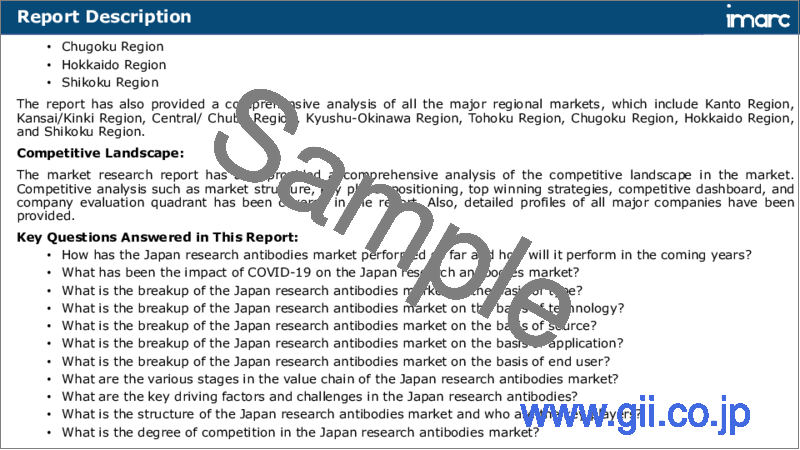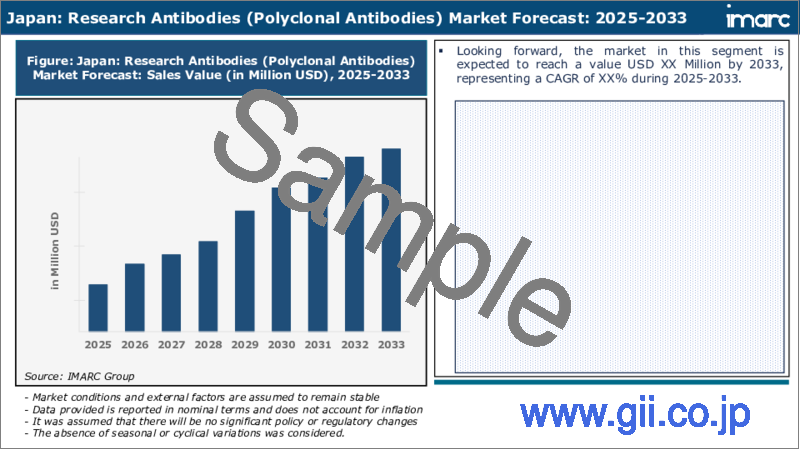|
|
市場調査レポート
商品コード
1746508
日本の研究用抗体市場レポート:タイプ、技術、供給源、用途、エンドユーザー、地域別、2025~2033年Japan Research Antibodies Market Report by Type, Technology, Source, Application, End User, and Region 2025-2033 |
||||||
カスタマイズ可能
|
|||||||
| 日本の研究用抗体市場レポート:タイプ、技術、供給源、用途、エンドユーザー、地域別、2025~2033年 |
|
出版日: 2025年06月02日
発行: IMARC
ページ情報: 英文 120 Pages
納期: 5~7営業日
|
全表示
- 概要
- 目次
日本の研究用抗体市場規模は2024年に2億3,650万米ドルに達しました。今後、IMARC Groupは、市場は2033年までに5億230万米ドルに達し、2025~2033年にかけて8.08%の成長率(CAGR)を示すと予測しています。継続的な医療の進歩とバイオテクノロジー産業の拡大が、主に市場成長の原動力となっています。
本レポートで扱う主要質問
- 日本の研究用抗体市場はこれまでどのように推移し、今後どのように推移するのか?
- COVID-19が日本の研究用抗体市場に与えた影響は?
- 日本の研究用抗体市場のタイプ別区分は?
- 日本の研究用抗体市場の技術別区分は?
- 日本の研究用抗体市場を供給源別に分類すると?
- 日本の研究用抗体市場の用途別区分は?
- 日本の研究用抗体市場のエンドユーザーによる区分は?
- 日本の研究用抗体市場のバリューチェーンにおける様々なステージとは?
- 日本の研究用抗体の主要な促進要因と課題は何か?
- 日本の研究用抗体市場の構造と主要参入企業は?
- 日本の研究用抗体市場における競合の程度は?
目次
第1章 序文
第2章 調査範囲と調査手法
- 調査の目的
- ステークホルダー
- データソース
- 市場推定
- 調査手法
第3章 エグゼクティブサマリー
第4章 日本の研究用抗体市場-イントロダクション
- 概要
- 市場力学
- 産業動向
- 競合情報
第5章 日本の研究用抗体市場情勢
- 過去と現在の市場動向(2019~2024年)
- 市場予測(2025~2033年)
第6章 日本の研究用抗体市場-タイプ別内訳
- モノクローナル抗体
- ポリクローナル抗体
第7章 日本の研究用抗体市場-技術別内訳
- 免疫化学
- 免疫蛍光法
- ウェスタンブロッティング
- フローサイトメトリー
- 免疫沈降法
- ELISA
- その他
第8章 日本の研究用抗体市場-供給源別内訳
- マウス抗体
- ウサギ抗体
- ヤギ抗体
- その他
第9章 日本の研究用抗体市場-用途別内訳
- 感染症
- 免疫学
- 腫瘍学
- 幹細胞
- 神経生物学
- その他
第10章 日本の研究用抗体市場-エンドユーザー別内訳
- 学術研究機関
- 契約研究機関
- 製薬とバイオテクノロジー企業
第11章 日本の研究用抗体市場-競合情勢
- 概要
- 市場構造
- 市場企業のポジショニング
- 主要成功戦略
- 競合ダッシュボード
- 企業評価象限
第12章 主要企業のプロファイル
第13章 日本の研究用抗体市場-産業分析
- 促進要因・抑制要因・機会
- ポーターのファイブフォース分析
- バリューチェーン分析
第14章 付録
Japan research antibodies market size reached USD 236.5 Million in 2024. Looking forward, IMARC Group expects the market to reach USD 502.3 Million by 2033, exhibiting a growth rate (CAGR) of 8.08% during 2025-2033. Continuous medical advancements, coupled with the expanding biotechnology industry, are primarily driving the market growth.
Antibodies, which are glycoproteins, serve as vital constituents of the immune system, and they are present in body fluids. They circulate within the bloodstream and serve as defenders against antigens, which are foreign substances such as viruses and bacteria. Due to their ability to specifically recognize and bind to antigens, antibodies are essential tools in biological research. Consequently, they play a pivotal role in identifying specific cellular components and are crucial in the development of routine diagnostic tests within the research domain. Several common technologies are extensively employed for antibody research, including immunohistochemistry (IHC), immunofluorescence, western blotting, flow cytometry, immunoprecipitation, and enzyme-linked immunosorbent assay (ELISA).
Japan Research Antibodies Market Trends:
The Japan research antibodies market is witnessing substantial growth and significance within the field of life sciences and medical research. This can be attributed to several key factors. Firstly, the country's robust commitment to scientific advancement and innovation has led to increased funding for research and development activities, spurring demand for research antibodies. Additionally, Japan's thriving pharmaceutical and biotechnology industries are driving the usage of high-quality antibodies for drug discovery, development, and diagnostic applications. The evolving healthcare landscape in Japan, marked by an aging population and increasing health concerns, has intensified the demand for antibodies in clinical research and diagnostics. Antibodies play a pivotal role in identifying disease markers and understanding complex biological pathways, contributing to the development of targeted therapies and precision medicine approaches. Furthermore, Japan's emphasis on personalized medicine and its growing significance in cancer research are bolstering the demand for research antibodies tailored to specific patient profiles. This personalized approach holds immense potential for improving treatment outcomes. The Japan research antibodies market encompasses a wide range of applications, including immunohistochemistry, flow cytometry, ELISA, and western blotting. With a strong foundation in scientific excellence, increasing research activities, and a commitment to cutting-edge medical advancements, the regional market is expected to catalyze in the coming years.
Japan Research Antibodies Market Segmentation:
Type Insights:
- Monoclonal Antibodies
- Polyclonal Antibodies
Technology Insights:
- Immunochemistry
- Immunofluorescence
- Western Blotting
- Flow Cytometry
- Immunoprecipitation
- ELISA
- Others
Source Insights:
- Mouse Antibodies
- Rabbit Antibodies
- Goat Antibodies
- Others
Application Insights:
- Infectious Diseases
- Immunology
- Oncology
- Stem Cells
- Neurobiology
- Others
End User Insights:
- Academic and Research Institutes
- Contract Research Organizations
- Pharmaceutical and Biotechnology Companies
Competitive Landscape:
The market research report has also provided a comprehensive analysis of the competitive landscape in the market. Competitive analysis such as market structure, key player positioning, top winning strategies, competitive dashboard, and company evaluation quadrant has been covered in the report. Also, detailed profiles of all major companies have been provided.
Key Questions Answered in This Report:
- How has the Japan research antibodies market performed so far and how will it perform in the coming years?
- What has been the impact of COVID-19 on the Japan research antibodies market?
- What is the breakup of the Japan research antibodies market on the basis of type?
- What is the breakup of the Japan research antibodies market on the basis of technology?
- What is the breakup of the Japan research antibodies market on the basis of source?
- What is the breakup of the Japan research antibodies market on the basis of application?
- What is the breakup of the Japan research antibodies market on the basis of end user?
- What are the various stages in the value chain of the Japan research antibodies market?
- What are the key driving factors and challenges in the Japan research antibodies?
- What is the structure of the Japan research antibodies market and who are the key players?
- What is the degree of competition in the Japan research antibodies market?
Table of Contents
1 Preface
2 Scope and Methodology
- 2.1 Objectives of the Study
- 2.2 Stakeholders
- 2.3 Data Sources
- 2.3.1 Primary Sources
- 2.3.2 Secondary Sources
- 2.4 Market Estimation
- 2.4.1 Bottom-Up Approach
- 2.4.2 Top-Down Approach
- 2.5 Forecasting Methodology
3 Executive Summary
4 Japan Research Antibodies Market - Introduction
- 4.1 Overview
- 4.2 Market Dynamics
- 4.3 Industry Trends
- 4.4 Competitive Intelligence
5 Japan Research Antibodies Market Landscape
- 5.1 Historical and Current Market Trends (2019-2024)
- 5.2 Market Forecast (2025-2033)
6 Japan Research Antibodies Market - Breakup by Type
- 6.1 Monoclonal Antibodies
- 6.1.1 Overview
- 6.1.2 Historical and Current Market Trends (2019-2024)
- 6.1.3 Market Forecast (2025-2033)
- 6.2 Polyclonal Antibodies
- 6.2.1 Overview
- 6.2.2 Historical and Current Market Trends (2019-2024)
- 6.2.3 Market Forecast (2025-2033)
7 Japan Research Antibodies Market - Breakup by Technology
- 7.1 Immunochemistry
- 7.1.1 Overview
- 7.1.2 Historical and Current Market Trends (2019-2024)
- 7.1.3 Market Forecast (2025-2033)
- 7.2 Immunofluorescence
- 7.2.1 Overview
- 7.2.2 Historical and Current Market Trends (2019-2024)
- 7.2.3 Market Forecast (2025-2033)
- 7.3 Western Blotting
- 7.3.1 Overview
- 7.3.2 Historical and Current Market Trends (2019-2024)
- 7.3.3 Market Forecast (2025-2033)
- 7.4 Flow Cytometry
- 7.4.1 Overview
- 7.4.2 Historical and Current Market Trends (2019-2024)
- 7.4.3 Market Forecast (2025-2033)
- 7.5 Immunoprecipitation
- 7.5.1 Overview
- 7.5.2 Historical and Current Market Trends (2019-2024)
- 7.5.3 Market Forecast (2025-2033)
- 7.6 ELISA
- 7.6.1 Overview
- 7.6.2 Historical and Current Market Trends (2019-2024)
- 7.6.3 Market Forecast (2025-2033)
- 7.7 Others
- 7.7.1 Historical and Current Market Trends (2019-2024)
- 7.7.2 Market Forecast (2025-2033)
8 Japan Research Antibodies Market - Breakup by Source
- 8.1 Mouse Antibodies
- 8.1.1 Overview
- 8.1.2 Historical and Current Market Trends (2019-2024)
- 8.1.3 Market Forecast (2025-2033)
- 8.2 Rabbit Antibodies
- 8.2.1 Overview
- 8.2.2 Historical and Current Market Trends (2019-2024)
- 8.2.3 Market Forecast (2025-2033)
- 8.3 Goat Antibodies
- 8.3.1 Overview
- 8.3.2 Historical and Current Market Trends (2019-2024)
- 8.3.3 Market Forecast (2025-2033)
- 8.4 Others
- 8.4.1 Historical and Current Market Trends (2019-2024)
- 8.4.2 Market Forecast (2025-2033)
9 Japan Research Antibodies Market - Breakup by Application
- 9.1 Infectious Diseases
- 9.1.1 Overview
- 9.1.2 Historical and Current Market Trends (2019-2024)
- 9.1.3 Market Forecast (2025-2033)
- 9.2 Immunology
- 9.2.1 Overview
- 9.2.2 Historical and Current Market Trends (2019-2024)
- 9.2.3 Market Forecast (2025-2033)
- 9.3 Oncology
- 9.3.1 Overview
- 9.3.2 Historical and Current Market Trends (2019-2024)
- 9.3.3 Market Forecast (2025-2033)
- 9.4 Stem Cells
- 9.4.1 Overview
- 9.4.2 Historical and Current Market Trends (2019-2024)
- 9.4.3 Market Forecast (2025-2033)
- 9.5 Neurobiology
- 9.5.1 Overview
- 9.5.2 Historical and Current Market Trends (2019-2024)
- 9.5.3 Market Forecast (2025-2033)
- 9.6 Others
- 9.6.1 Historical and Current Market Trends (2019-2024)
- 9.6.2 Market Forecast (2025-2033)
10 Japan Research Antibodies Market - Breakup by End User
- 10.1 Academic and Research Institutes
- 10.1.1 Overview
- 10.1.2 Historical and Current Market Trends (2019-2024)
- 10.1.3 Market Forecast (2025-2033)
- 10.2 Contract Research Organizations
- 10.2.1 Overview
- 10.2.2 Historical and Current Market Trends (2019-2024)
- 10.2.3 Market Forecast (2025-2033)
- 10.3 Pharmaceutical and Biotechnology Companies
- 10.3.1 Overview
- 10.3.2 Historical and Current Market Trends (2019-2024)
- 10.3.3 Market Forecast (2025-2033)
11 Japan Research Antibodies Market - Competitive Landscape
- 11.1 Overview
- 11.2 Market Structure
- 11.3 Market Player Positioning
- 11.4 Top Winning Strategies
- 11.5 Competitive Dashboard
- 11.6 Company Evaluation Quadrant
12 Profiles of Key Players
- 12.1 Company A
- 12.1.1 Business Overview
- 12.1.2 Product Portfolio
- 12.1.3 Business Strategies
- 12.1.4 SWOT Analysis
- 12.1.5 Major News and Events
- 12.2 Company B
- 12.2.1 Business Overview
- 12.2.2 Product Portfolio
- 12.2.3 Business Strategies
- 12.2.4 SWOT Analysis
- 12.2.5 Major News and Events
- 12.3 Company C
- 12.3.1 Business Overview
- 12.3.2 Product Portfolio
- 12.3.3 Business Strategies
- 12.3.4 SWOT Analysis
- 12.3.5 Major News and Events
- 12.4 Company D
- 12.4.1 Business Overview
- 12.4.2 Product Portfolio
- 12.4.3 Business Strategies
- 12.4.4 SWOT Analysis
- 12.4.5 Major News and Events
- 12.5 Company E
- 12.5.1 Business Overview
- 12.5.2 Product Portfolio
- 12.5.3 Business Strategies
- 12.5.4 SWOT Analysis
- 12.5.5 Major News and Events
13 Japan Research Antibodies Market - Industry Analysis
- 13.1 Drivers, Restraints, and Opportunities
- 13.1.1 Overview
- 13.1.2 Drivers
- 13.1.3 Restraints
- 13.1.4 Opportunities
- 13.2 Porters Five Forces Analysis
- 13.2.1 Overview
- 13.2.2 Bargaining Power of Buyers
- 13.2.3 Bargaining Power of Suppliers
- 13.2.4 Degree of Competition
- 13.2.5 Threat of New Entrants
- 13.2.6 Threat of Substitutes
- 13.3 Value Chain Analysis





